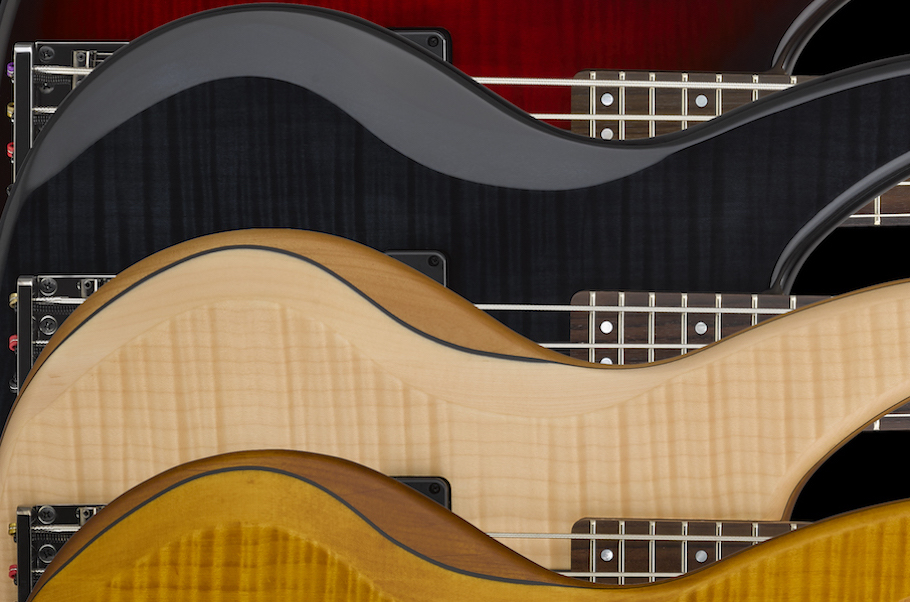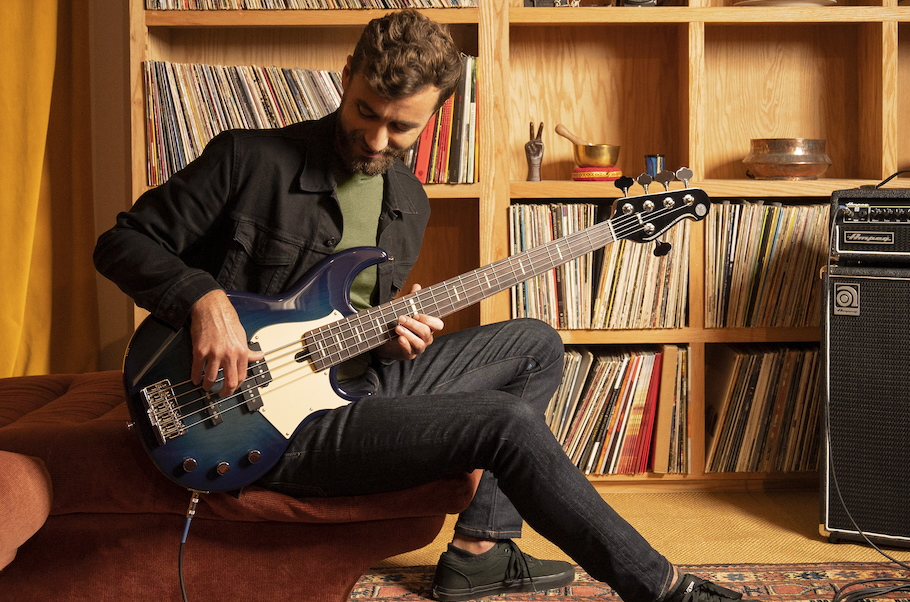Choosing the Right Bass Guitar, Part 2: Active vs. Passive
Weighing the pros and cons of each.
Perfection is in the eye of the beholder, and perhaps nowhere more so than when defining the perfect bass guitar. As we discussed in Part 1 of this article, some players prefer four strings on their instrument, while others want five (or more). Some say long scale, others say short scale. Solid body or hollow body, bolt-on neck or neck-through, fretted or fretless … the list of differentiating and distinguishing features, qualities, characteristics, specifications, materials, designs and components goes on and on.
Yet whatever your preferences, there always seems to be just enough logic to keep the argument festering. And so, in that spirit, let’s focus here on one of the trickier decisions you can make about a bass guitar: Active or passive?
An active bass is an instrument equipped with an onboard, internally-mounted, battery-powered preamp (usually nine volts but sometimes 18 volts) that boosts and equalizes the pickup’s signal before it arrives at the output jack. In some cases, an active bass will even be equipped with pickups that require power. In contrast, a passive bass has none of the above … and to confuse things even further, some basses are switchable between active and passive modes.
So which should you choose?
On the surface, the debate between active versus passive may appear to be between new-fangled complexity and tried-and-true simplicity. But as you may have already guessed, it’s far more complicated than that. So without further ado, let’s explore the pros and cons of each:
Active: The Pros
Bassists often use adjectives like “snappy,” “sparkly” or “sizzling” to describe the sound of an active bass. These descriptions are likely attributable to the fact that active basses enable you to shape your tone much more than a comparable passive bass.

The tone controls on a passive bass can only cut frequencies, but the tone controls on an active bass allow you to boost frequencies too, giving you much more flexibility. This can be especially helpful if you play in a cover band where you need to wander across a diverse tonal landscape during a set, or if you want to dial in a specific signature sound for a specific genre like slap or grind metal. Many active basses have three- or even four-band EQs, letting you select specific frequencies to sculpt your bass sound before your signal even gets to your amp. Several Yamaha basses are equipped with three-band EQ and active/passive electronics, including the BB700 Series and the TRBX600 Series.
In addition to greater tonal control, active basses introduce far less noise and interference than passive basses, as well as delivering a stronger signal with less degradation than their passive counterparts. This gives your amp a cleaner, much hotter signal to work with. Bear in mind, however, that you can always roll off the volume slightly on an active bass to reduce some of the hi-fi qualities for a more “passive” sound.
Active: The Cons
To the ears of those who prefer passive basses, active basses aren’t very dynamic sounding. Sure, their signal is hot and consistent, but it can sound compressed. In addition, putting all of that frequency boosting control in the wrong hands can lead to a painful amount of ear-splitting hiss if treble frequencies get cranked too aggressively.
Also, if you’re the practical type, you also need to be fully aware that when the battery in your active bass dies, your sound will die with it … unless, of course, you have a bass that’s active/passive switchable. Changing out a dead battery for a new one on an active bass with a hinged battery compartment isn’t a big deal in theory, but only if you’re prepared with a fresh battery. If you don’t have a fresh battery on hand, or if your bass’ battery compartment is accessible behind screws, it’s a huge deal … especially if you’re on stage, in the middle of a set. It’s like getting a flat tire in your car and realizing that the spare is in the garage or doesn’t have air in it. And on the same note, players who habitually leave their instrument cable plugged in should be aware of this painful fact: If you do that with an active bass you’ll be draining and replacing batteries faster than you can say “a pack of fresh 9-volts, please.”
Passive: The Pros

Bassists often use adjectives like “earthy,” “warm,” “full,” “punchy” or “round” to describe the sound of a passive bass. That’s likely because passive basses rely on less circuitry than their active counterparts, and so they deliver a sound that’s more pure, and more sensitive to “touch” from a player capable of finessing real dynamics out of their instrument. Yamaha offers a wide array of passive basses, including the RBX Series and most of the BB Series.
The tone controls on a passive bass are much simpler than those found on active basses. No micro-switches or tiny pots inside the control cavity to tweak, no hissy highs or blossoming bottoms to contend with. Just straightforward tone and volume controls that are wide open when rotated to the right, and cut frequencies or volume when rolled off to the left. This leaves you with a more dynamic attack that doesn’t have to fight against the compression inherent in many active bass circuits.
Playing a passive bass means not ever worrying about what can go wrong with onboard active electronics. Sure, something can go wrong with any bass, but there are less connections, components, and overall circuitry that can develop issues — no batteries that can run out of power in the middle of a set or session, no circuit boards that can work loose, and fewer wires to become unsoldered. And while you may not have the steroidal tone shaping of an active bass at your fingertips, you can always get the extra oomph from any decent quality bass amp — its tone shaping capabilities should at least be comparable to that of an active bass.
Passive: The Cons
There’s no getting around the fact that the signal coming from a passive bass is not as strong as on an active bass. That doesn’t matter if the pickup on that bass is delivering a sufficiently “hot” signal, but if it’s actually weak, that’s a bonafide problem, especially if you use long cables and don’t have the best amp in the world. In such instances, you might actually introduce noise and RF interference from nearby computer monitors and fluorescent lighting. In addition, compensating for weak output often requires you to rely on your amp’s gain, and doing so may mean introducing undesirable but very audible noise from the amp’s circuitry.
Clearly there are upsides and downsides on both sides of this debate, but if you want the best of both worlds you can always consider a bass that comes equipped with an active/passive switch to change how the signal courses through your bass’ electronics. When it’s in active mode, you get the hotter signal and monstrous tonal shaping capabilities. And when it’s passive, you get the dynamic control and safety net in case your battery gives up the ghost.
One last note: Regardless of whether you prefer active over passive or vice versa, remember that there are lots of other variables that will contribute to your sound. If you’re fortunate enough to find a bass that meets most, if not all, of your criteria, all of these nuances will become irrelevant as you get accustomed to your instrument, and everything but the music will eventually recede into the background.














